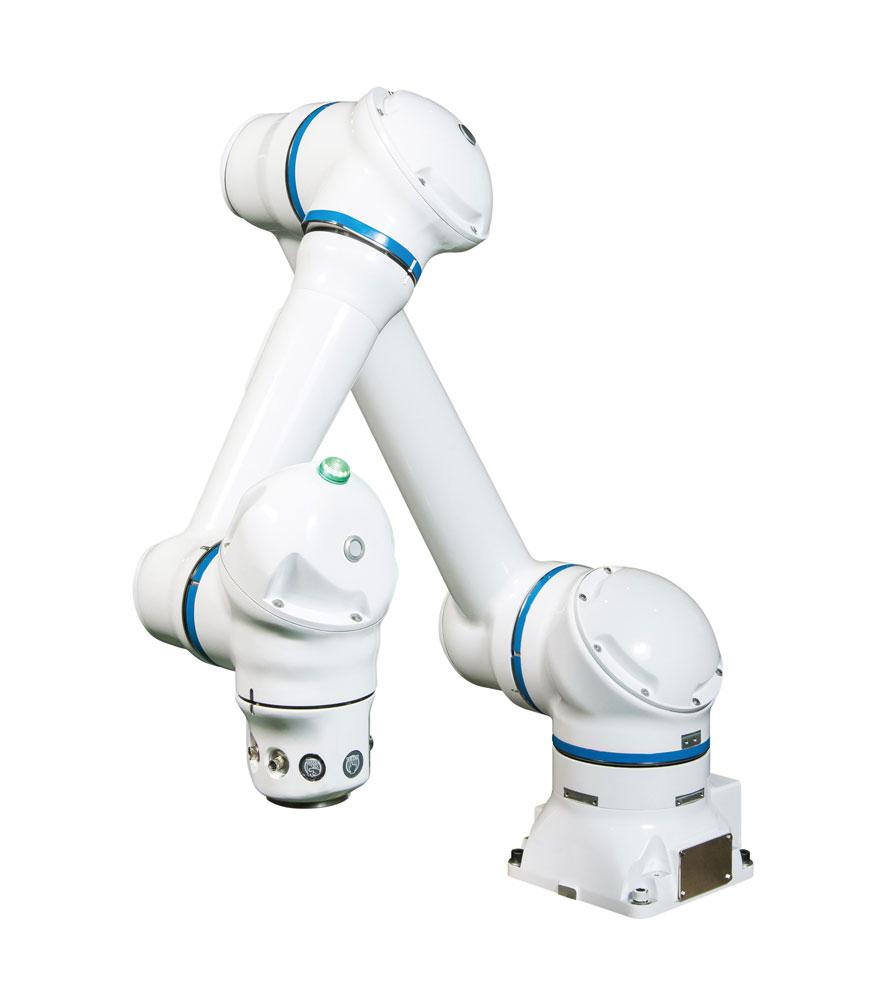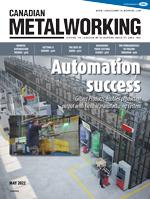Product Manager, Welding
- FMA
- The Fabricator
- FABTECH
- Canadian Metalworking
Robotic automation trends
Flexibility, mobility, collaboration are leading the way for robot implementations
- By Josh Leath
- May 30, 2022
- Article
- Automation and Software

Reliable robotic automation with intuitive tools helps manufacturers navigate their way to greater operational efficiency and product quality. Andriy Onufriyenko
Rapidly changing technology, consumer demands, and competitive pressures continue to inspire dynamic operational strategies, propelling the widespread use of robotic automation for both automotive and non-automotive sectors.
From metal to plastic parts, the use of fast, flexible robots is effectively addressing general market fluctuations, supply chain challenges, and skilled labour shortages. This is especially true for small and medium-sized manufacturers, including job shops, looking to ease productivity declines and bolster revenue streams.
The ability to make exceptional products with minimal expense is a must to stay competitive in today’s high-mix/low-volume industrial landscape. As automation costs fall and ease of use increases, a steady number of highly adaptable robots permeate shop floors. Now seen as an asset, robot availability reassures potential clients that expectations for on-time delivery and product quality can be met.
Following are some growing trends that are making transformative differences.
User-friendly Robot Deployment
Through machine tending, arc welding, and even injection molding, numerous applications benefit from reduced-interference robot designs with robust performance capability. The trend for workspace optimization has business owners retrofitting current operations.
Whether a shop is adding a single robot to existing automation or several to another location, extremely flexible robots excel at a variety of repetitive, dangerous tasks. Via this implementation, manufacturers are realizing the value that applications like machine tending can have on production. By loading/unloading a CNC machine or tending another piece of equipment for grinding, stamping, or trimming, highly repeatable robots expertly hold, orient, and transport parts.
Expected to grow by 40 per cent over the next six years1, easy-to-use collaborative robots are helping new and highly relevant applications come to life. Precision hand-guided teaching is a key aspect of this trend, making it a suitable option for shops wanting to integrate a highly versatile, user-friendly robotic system. Well-suited for high-mix/low-batch runs, cobots also can be used to perform arc welding, machine tending, light assembly, and palletizing in tight spaces where they need to work with, or in close contact to, humans.
Robots with built-in, safety-rated power and force limiting (PFL) technology easily supplement manual tasks or can be moved next to large, heavy workpieces in a factory. Not only does this provide additional capacity needed in smaller operations, but it also maximizes floor space. Also adept at saving valuable floor space are higher-payload cobots, especially for end-of-line palletizing.
Compact Workcell Integration
Scaling up production in job shop settings, compact workcells with space-saving robots and intuitive technologies are an attractive option to shop owners wanting to improve manufacturing capacity and/or part aesthetics. Pre-engineered robotic workcells with integrated cable management and a common base for easy installation and relocation are optimizing small- to medium-part creation in these situations.
Easy-to-use Pendants
Bolstering user confidence for robotic implementation are tablet-style teach pendants with improved graphic user interfaces. Complementing this intuitive pendant technology, a growing list of feature-rich pendant applications continue to permeate historic programming barriers. In the welding industry, for example, tools like the Universal Weldcom Interface (UWI) help programmers gain control of any weld process or parameter, including voltage, amperage, and wire feed speed.

The 6-axis HC10DTP collaborative robot can easily supplement simple manual tasks or be moved next to large, heavy workpieces on the shop floor.
Taking simple-to-use technology a step farther is the concept of cross-platform robotic automation. Capable of allowing nearly anyone to program almost any robot, this automation introduced by READY Robotics provides robot users with graphic icon-based programming that does not require specific coding experience.
Offline Programming
Workforce demographics and market drivers continue to shift the way manufacturers approach robot integration and programming. Intuitive programming options–including offline programming (OLP)–often are a necessity today for facilitating a high degree of uptime, especially for operations that cannot afford to interrupt production while a robot program is being written point by point from a teach pendant.
Using a 3D representation of a robotic workcell that visually shows a robot moving along a programmed path, OLP gives both experienced and novice programmers the ability to design, test, and adjust a robot job from a PC-based virtual environment.
A growing number of manufacturers are realizing the time- and cost-saving benefits these platforms provide. Offering helpful features, such as collision detection, 3D PDFs, conveyor tracking, and cam path, Yaskawa’s MotoSim is a user-friendly software option that is suitable for programming and reach studies. Other third-party options provide robust functionality, allowing task experts to program robots quickly with ease. Robotmaster, Octopuz, and Delfoi provide comprehensive software for numerous applications.
Widely popular for welding robots and workcells, OLP is gaining traction for machine tending applications, optimizing system utilization for greater throughput and minimizing human error for increased worker safety and product quality.
Convenient Robot Acquisition
Advances in artificial intelligence (AI), simulation, and modular hardware continue to contribute to greater capability for robot dexterity. Developers are creating proprietary vision and perception systems that can efficiently recognize a package or part in space, then adjust the robot path and peripheral parameters in real time to facilitate fluid production.
Savvy system developers now are offering Robots as a Service (RaaS), which requires little to no programming knowledge from the end user. This unique acquisition method can significantly reduce roadblocks to robotic implementation and facilitates several key benefits:
Increased automation confidence. Not all manufacturers employ a highly trained robot operator (a.k.a. a workcell champion) who knows all the ins and outs of robotic automation. In fact, this scenario is quite rare. That said, the RaaS business model is especially suitable for small and medium-sized shops looking to test out robots before committing to long-term use.
Lower implementation costs. When it comes to robotics, smaller operations may hesitate to pay large upfront costs. RaaS helps alleviate this, providing organizations with a logical alternative to buying a robot outright and usually realizing immediate payback. Whether through a monthly leasing agreement or a rent-to-own approach, RaaS helps organizations improve their bottom line.
Greater production scalability. Traditional business models are being challenged. Safe, out-of-the-box robotic systems that provide simple programming allow manufacturers with limited staff to adjust to short-term or long-term needs, such as seasonal business, accordingly. From collaborative machine tending systems to pre-assembled robotic welding workcells, companies are using these assets to accelerate throughput as requirements change.

The industry’s first IP67-rated collaborative robot, the 20-kg-payload-capacity HC20DTP, can load/unload a 40- by 48-in. pallet (up to 80 in. tall) without an elevator.
Easy robot maintenance. Many companies that offer RaaS remain integral key resources for their clients by monitoring the robotic system remotely and providing troubleshooting and system reprogramming as needed for maximized uptime and ROI.
Frequently used for material handling and logistics tasks, the global RaaS market is projected to triple over the next six years2 as the popularity of this concept is creating specialized niches.
Asset Management Integration
To facilitate continuous improvement and provide the ability to monitor and manage connected devices remotely, manufacturers also are implementing user-friendly device management platforms.
Innovative software tools like this help to easily monitor, accumulate, and visually deliver data in real time for all connected devices (including robots and their peripherals) in a production environment. This allows for data-driven planning for preventive and predictive maintenance, optimizing life cycle management.
The enormous amount of data connected devices provide is best captured with edge server systems. Using a leading OPC-UA or other data collection interface, asset management systems provide comprehensive insights to manufacturers looking to gain a competitive edge.
Moving forward, economic pressures and technological advances will continue to fuel market demands and subsequent innovation. Manufacturers that execute operational strategies that embrace new methods and technologies, including robotic automation, will most likely be able to adjust to market fluctuations quickly for ongoing success.
Josh Leath is product manager welding at Yaskawa America Inc. – Motoman Robotics Division, 100 Automation Way, Miamisburg, Ohio 45342, 937-847-6200, www.motoman.com.
Notes
1. “Collaborative Robots Market Size, Share & COVID-19 Impact Analysis,” Fortune Business Insights, 2020.
2. “Robots as a Service Market to Reach US$41.3 Billion …,” CISION PR Newswire, 2021.
About the Author
Related Companies
subscribe now


Keep up to date with the latest news, events, and technology for all things metal from our pair of monthly magazines written specifically for Canadian manufacturers!
Start Your Free Subscription- Industry Events
MME Winnipeg
- April 30, 2024
- Winnipeg, ON Canada
CTMA Economic Uncertainty: Helping You Navigate Windsor Seminar
- April 30, 2024
- Windsor, ON Canada
CTMA Economic Uncertainty: Helping You Navigate Kitchener Seminar
- May 2, 2024
- Kitchener, ON Canada
Automate 2024
- May 6 - 9, 2024
- Chicago, IL
ANCA Open House
- May 7 - 8, 2024
- Wixom, MI




















